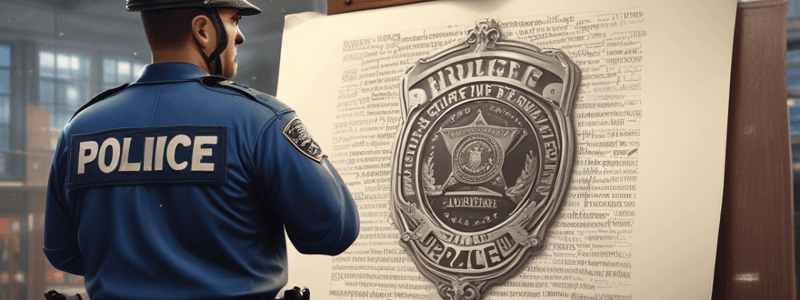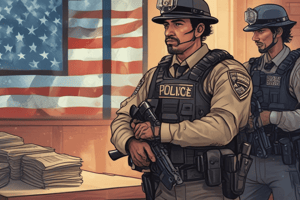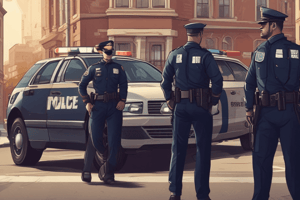Podcast
Questions and Answers
What is the primary concern regarding the prone position for restrained individuals?
What is the primary concern regarding the prone position for restrained individuals?
- Risk of positional asphyxia and respiratory failure
- Increased risk of cardiac events due to heart disease
- Exacerbation of asthma-related problems
- All of the above (correct)
What is the purpose of hobbles, according to the policy?
What is the purpose of hobbles, according to the policy?
- To immobilize the legs of combative subjects (correct)
- To secure handcuffs to the legs of subjects
- To restrain the arms of combative subjects
- To prevent positional asphyxia in restrained subjects
Which of the following is NOT an example of a hobble, according to the policy?
Which of the following is NOT an example of a hobble, according to the policy?
- Metal chains (correct)
- Cotton or nylon rope with a fixed loop
- Flexible handcuffs
- Commercial leg restraint devices
What is the legal standard for 'reasonable suspicion' as defined in the policy?
What is the legal standard for 'reasonable suspicion' as defined in the policy?
According to the policy, what is the definition of 'hog tying'?
According to the policy, what is the definition of 'hog tying'?
Based on the policy, which of the following statements is TRUE regarding positional asphyxia?
Based on the policy, which of the following statements is TRUE regarding positional asphyxia?
According to the policy, when is it permissible for an officer to leave a restrained subject unsupervised?
According to the policy, when is it permissible for an officer to leave a restrained subject unsupervised?
Which of the following statements is true regarding the use of handcuffs, according to the policy?
Which of the following statements is true regarding the use of handcuffs, according to the policy?
According to the policy, which of the following subjects should NOT be handcuffed or restrained unless there is a reasonable suspicion that they pose a danger?
According to the policy, which of the following subjects should NOT be handcuffed or restrained unless there is a reasonable suspicion that they pose a danger?
Based on the policy, which of the following statements regarding the use of leg restraints is correct?
Based on the policy, which of the following statements regarding the use of leg restraints is correct?
According to the policy, what should an officer do when transporting a subject in leg restraints?
According to the policy, what should an officer do when transporting a subject in leg restraints?
Based on the policy, which of the following statements regarding the use of temporary restraints (such as flex-cuffs or cord-cuffs) is correct?
Based on the policy, which of the following statements regarding the use of temporary restraints (such as flex-cuffs or cord-cuffs) is correct?
According to the policy, in which of the following scenarios would an officer NOT be required to state in the PortalOne Booking/Arrest Report that the subject's legs had to be immobilized with leg restraints?
According to the policy, in which of the following scenarios would an officer NOT be required to state in the PortalOne Booking/Arrest Report that the subject's legs had to be immobilized with leg restraints?
Based on the policy, which of the following statements regarding the transportation of restrained subjects is correct?
Based on the policy, which of the following statements regarding the transportation of restrained subjects is correct?
According to the policy, which of the following statements regarding the use of a restraint cord as a waist belt is correct?
According to the policy, which of the following statements regarding the use of a restraint cord as a waist belt is correct?
What is the primary purpose of using hobbles according to the policy?
What is the primary purpose of using hobbles according to the policy?
Which of the following scenarios would NOT require an officer to state in the PortalOne Booking/Arrest Report that the subject's legs had to be immobilized with leg restraints?
Which of the following scenarios would NOT require an officer to state in the PortalOne Booking/Arrest Report that the subject's legs had to be immobilized with leg restraints?
Which of the following statements regarding the use of temporary restraints, such as flex-cuffs or cord-cuffs, is correct according to the policy?
Which of the following statements regarding the use of temporary restraints, such as flex-cuffs or cord-cuffs, is correct according to the policy?
According to the policy, which of the following subjects should NOT be handcuffed or restrained unless there is a reasonable suspicion that they pose a danger?
According to the policy, which of the following subjects should NOT be handcuffed or restrained unless there is a reasonable suspicion that they pose a danger?
What is the legal standard for 'reasonable suspicion' as defined in the policy?
What is the legal standard for 'reasonable suspicion' as defined in the policy?
According to the policy, what is the primary concern regarding the prone position for restrained individuals?
According to the policy, what is the primary concern regarding the prone position for restrained individuals?
According to the policy, when can an officer briefly place a handcuffed subject in the prone position?
According to the policy, when can an officer briefly place a handcuffed subject in the prone position?
According to the policy, which of the following statements regarding the use of restraint cords as waist belts is correct?
According to the policy, which of the following statements regarding the use of restraint cords as waist belts is correct?
Based on the policy, in which scenario would an officer NOT be required to state in the PortalOne Booking/Arrest Report that the subject's legs were immobilized with leg restraints?
Based on the policy, in which scenario would an officer NOT be required to state in the PortalOne Booking/Arrest Report that the subject's legs were immobilized with leg restraints?
According to the policy, which of the following statements regarding the use of temporary restraints (such as flex-cuffs or cord-cuffs) is NOT correct?
According to the policy, which of the following statements regarding the use of temporary restraints (such as flex-cuffs or cord-cuffs) is NOT correct?
Based on the policy, which of the following statements regarding the transportation of restrained subjects is NOT correct?
Based on the policy, which of the following statements regarding the transportation of restrained subjects is NOT correct?
According to the policy, which of the following subjects should be handcuffed or restrained at the officer's discretion?
According to the policy, which of the following subjects should be handcuffed or restrained at the officer's discretion?
According to the policy, which of the following statements regarding positional asphyxia is NOT true?
According to the policy, which of the following statements regarding positional asphyxia is NOT true?
According to the policy, which of the following statements regarding the 'hog tying' restraint position is correct?
According to the policy, which of the following statements regarding the 'hog tying' restraint position is correct?
According to the policy, which of the following statements regarding the use of leg restraints (hobbles) is NOT correct?
According to the policy, which of the following statements regarding the use of leg restraints (hobbles) is NOT correct?
Flashcards are hidden until you start studying




